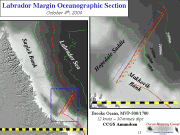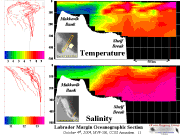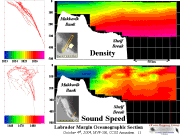Prior to arriving at the
Makkovik survey site, the MVP was experimentally deployed at 30
minute intervals whilst steaming in transit up the continental margin
at 12
knots. The system cycled to 300m depth for areas with greater depths.
In shallower depths, the towfish was set to recover at a depth of 20m
above the seabed. These data were used to examine the transition from
the Labrador Sea water masses (surface temperatures up to 9 degrees C)
across the edge of the Labrador Current.
|
The Labrador current was
particularily evident with surface salinities of as low as 30.5 ppt and
deeper temperatures as low as 2 degrees C (as opposed to a toasty 9
degrees out in the centre of the Labrador Sea). The front between the
two water masses is very abrupt, occuring within a zone around 10 km
wide. The location of the front is extremely close to the site of the
desired bank survey indicating that the spatial variation in
oceanographic properties were likely to be a cause of concern in the
refraction correction of the EM300 multibeam data. |
Converting the CTD data to
density and sound speed, one clearly sees that the temperature
signature dominates the sound speed structure, whereas the salinity
variations dominate the density field (that in turn controls the
baroclinic component of the circulation).
|


